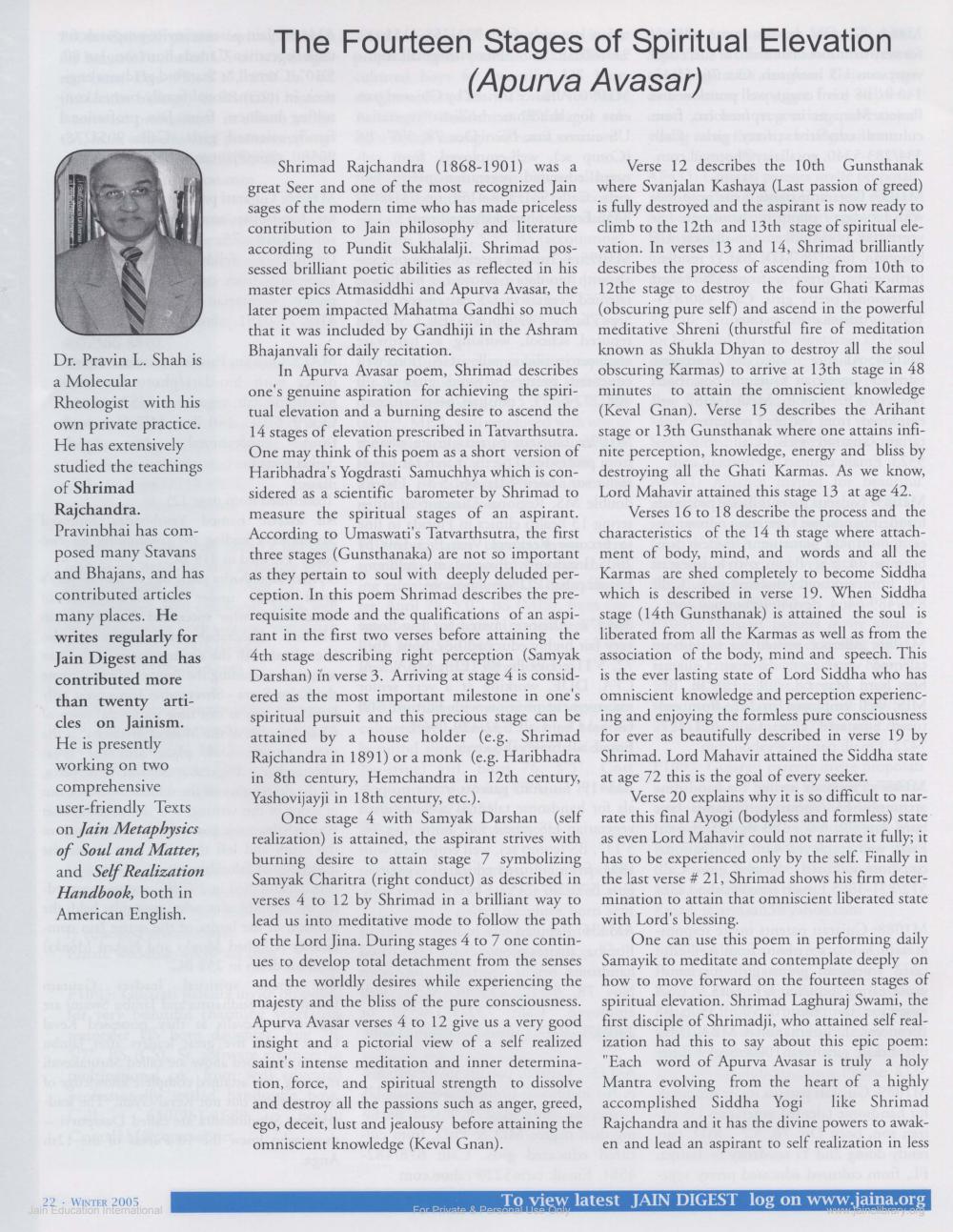________________
Dr. Pravin L. Shah is a Molecular Rheologist with his own private practice. He has extensively studied the teachings of Shrimad Rajchandra. Pravinbhai has composed many Stavans and Bhajans, and has contributed articles many places. He writes regularly for Jain Digest and has contributed more than twenty articles on Jainism. He is presently working on two comprehensive user-friendly Texts on Jain Metaphysics of Soul and Matter, and Self Realization Handbook, both in American English.
22 WINTER 2005, Jain Education International
The Fourteen Stages of Spiritual Elevation (Apurva Avasar)
Shrimad Rajchandra (1868-1901) was a great Seer and one of the most recognized Jain sages of the modern time who has made priceless contribution to Jain philosophy and literature according to Pundit Sukhalalji. Shrimad possessed brilliant poetic abilities as reflected in his master epics Atmasiddhi and Apurva Avasar, the later poem impacted Mahatma Gandhi so much that it was included by Gandhiji in the Ashram Bhajanvali for daily recitation.
In Apurva Avasar poem, Shrimad describes one's genuine aspiration for achieving the spiritual elevation and a burning desire to ascend the 14 stages of elevation prescribed in Tatvarthsutra. One may think of this poem as a short version of Haribhadra's Yogdrasti Samuchhya which is considered as a scientific barometer by Shrimad to measure the spiritual stages of an aspirant. According to Umaswati's Tatvarthsutra, the first three stages (Gunsthanaka) are not so important as they pertain to soul with deeply deluded perception. In this poem Shrimad describes the prerequisite mode and the qualifications of an aspirant in the first two verses before attaining the 4th stage describing right perception (Samyak Darshan) in verse 3. Arriving at stage 4 is considered as the most important milestone in one's spiritual pursuit and this precious stage can be attained by a house holder (e.g. Shrimad Rajchandra in 1891) or a monk (e.g. Haribhadra in 8th century, Hemchandra in 12th century, Yashovijayji in 18th century, etc.).
Once stage 4 with Samyak Darshan (self realization) is attained, the aspirant strives with burning desire to attain stage 7 symbolizing Samyak Charitra (right conduct) as described in verses 4 to 12 by Shrimad in a brilliant way to lead us into meditative mode to follow the path of the Lord Jina. During stages 4 to 7 one continues to develop total detachment from the senses and the worldly desires while experiencing the majesty and the bliss of the pure consciousness. Apurva Avasar verses 4 to 12 give us a very good insight and a pictorial view of a self realized saint's intense meditation and inner determination, force, and spiritual strength to dissolve and destroy all the passions such as anger, greed, ego, deceit, lust and jealousy before attaining the omniscient knowledge (Keval Gnan).
Verse 12 describes the 10th Gunsthanak where Svanjalan Kashaya (Last passion of greed) is fully destroyed and the aspirant is now ready to climb to the 12th and 13th stage of spiritual elevation. In verses 13 and 14, Shrimad brilliantly describes the process of ascending from 10th to 12the stage to destroy the four Ghati Karmas (obscuring pure self) and ascend in the powerful meditative Shreni (thurstful fire of meditation known as Shukla Dhyan to destroy all the soul obscuring Karmas) to arrive at 13th stage in 48 minutes to attain the omniscient knowledge (Keval Gnan). Verse 15 describes the Arihant stage or 13th Gunsthanak where one attains infinite perception, knowledge, energy and bliss by destroying all the Ghati Karmas. As we know, Lord Mahavir attained this stage 13 at age 42.
Verses 16 to 18 describe the process and the characteristics of the 14 th stage where attachment of body, mind, and words and all the Karmas are shed completely to become Siddha which is described in verse 19. When Siddha stage (14th Gunsthanak) is attained the soul is liberated from all the Karmas as well as from the association of the body, mind and speech. This is the ever lasting state of Lord Siddha who has omniscient knowledge and perception experiencing and enjoying the formless pure consciousness for ever as beautifully described in verse 19 by Shrimad. Lord Mahavir attained the Siddha state at age 72 this is the goal of every seeker.
Verse 20 explains why it is so difficult to narrate this final Ayogi (bodyless and formless) state as even Lord Mahavir could not narrate it fully; it has to be experienced only by the self. Finally in the last verse # 21, Shrimad shows his firm determination to attain that omniscient liberated state with Lord's blessing.
One can use this poem in performing daily Samayik to meditate and contemplate deeply on how to move forward on the fourteen stages of spiritual elevation. Shrimad Laghuraj Swami, the first disciple of Shrimadji, who attained self realization had this to say about this epic poem: "Each word of Apurva Avasar is truly a holy Mantra evolving from the heart of a highly accomplished Siddha Yogi like Shrimad Rajchandra and it has the divine powers to awaken and lead an aspirant to self realization in less
To view latest JAIN DIGEST log on www.jaina.org
For Private & Personal Use Only




